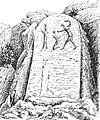Place:Aadloun stele
[ ⚑ ] 33°24′14″N 35°16′26″E / 33.404°N 35.274°E The Aadloun stele is a rock relief stele and inscription carved into the limestone rocks around the town of Aadloun in Lebanon, between Sidon and Tyre. Although heavily weathered when discovered in 1843, it was attributed to Ramesses II. It has been compared to the Stelae of Nahr el-Kalb approximately 60km to the north.
In his 1843 publication of the stele,Jules de Bertou wrote:[1]
The shape of [Aadloun's rock-cut] tombs is not the only stamp of antiquity that distinguishes this necropolis from other burial places found in Syria. We also see one of these Egyptian steles, quite similar to those we have drawn on the banks of Nahar-el-Kelb, not far from Beirut. The Adloun stele depicted a conqueror making an offering of prisoners to the god Phtha. This is all that can be recognized, even with the help of the shadows projected by the light of a torch. The corrosive action of the sea air has erased the hieroglyphic legend that covered this stele from the height of the god's shoulders to the bottom of the frame, and only a few isolated signs are visible.
Gallery
See also
- Egyptian Stelae in the Levant
- Stelae of Nahr el-Kalb
Notes
- ↑ de Bertou, J. (1843) (in fr). Essai sur la topographie de Tyr. Typ. Firmin Didot frères. p. 85. https://books.google.com/books?id=zL4fN14cYHMC&pg=PA85. Retrieved 2023-04-21. "Parmi les tombeaux d'Adloun, il en est plusieurs qui, destinés, sans doute, à des personnages importants, peut-être aux rois de Tyr, ont été pratiqués dans des morceaux de rochers séparés de la masse; ceux-là par leur forme de pyramides monolithes et tronquées, rappellent les monuments funéraires de Pétra. La forme de ces tombeaux n'est pas le seul cachet d'antiquité qui distingue cette nécropole des autres lieux de sépulture qu'on rencontre en Syrie. On y voit aussi une de ces stèles égyptiennes, tout à fait semblable à quelquesunes de celles que nous avons dessinées sur les bords du fleuve Lycus (Nahar-el-Kelb), qui coule non loin de Beyrouth. La stèle d'Adloun représentait un conquérant faisant au dieu Phtha une offrande de prisonniers. C'est là tout ce qu'on y peut reconnaître, même en s'aidant du jeu des ombres projetées par la lueur d'un flambeau. L'action corrosive de l'air de la mer a effacé la légende hiéroglyphique qui couvrait ce tableau depuis la hauteur des épaules du dieu jusqu'en bas du cadre, et il n'y a plus de visible que quelques signes isolés."
References
- de Bertou, J. (1843) (in fr). Essai sur la topographie de Tyr. Typ. Firmin Didot frères. https://books.google.com/books?id=zL4fN14cYHMC&pg=PA85. Retrieved 2023-04-21.
- de Bertou, J. (1854) (in fr). Lettre à M. de Sauley sur les monuments égyptiens de Nahr-el-Kelb. Leleux. https://books.google.com/books?id=cJcwoFXC_dEC&pg=PA11. Retrieved 2023-04-21.
- Ronzevalle, Sébastien (1909). "Notes et études d'Archéologie orientale" (in fr). Mélanges de la Faculté orientale (PERSEE Program) 3 (2): 753–804. doi:10.3406/mefao.1909.920. ISSN 0256-5587. https://www.persee.fr/doc/mefao_0256-5587_1909_num_3_2_920.
 |






